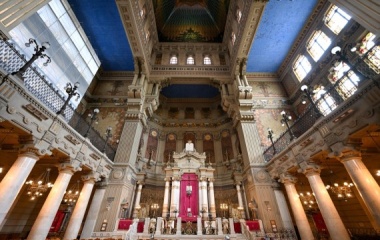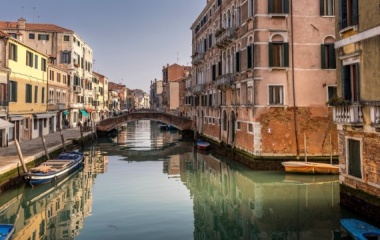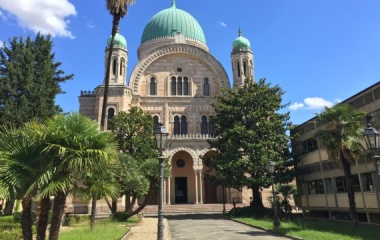
A city close to 3,000 years old, capital of its modern counterpart, a walled old city surrounded by a modern new city, buildings 2,000 years old next to those 20 years old, ancient ruins galore, hundreds of houses of worship, an uninterrupted Jewish presence of thousands of years. Welcome to Rome, a place so much alike and yet so different from Jerusalem.
“Rome, and Jerusalem. If, they say to you both are destroyed, do not believe, they are both settled, do not believe. But if they say Rome is destroyed and Jerusalem is settled, Jerusalem is destroyed and Caesarea is settled, believe. As it says, 'I shall be filled with her that is laid waste'” (Ezekiel 26:2), if this city is filled, that one is laid waste, if that city is filled, this one is laid waste” (Megillah 6a).
Rome and Jerusalem reflect different world views and in the eyes of the Rabbis this was a zero-sum game. When one prospered the other had to suffer and when one suffered the other must be prospering. The Temple and those who destroy the Temple cannot exist in harmony. The fate of the two are intertwined – but in opposite directions.
In the rabbinic mindset Rome is identified with Eisav – the polar opposite of Yaakov – and when Christianity becomes the official religion of the Roman Empire, Rome becomes identified with Christianity itself – a religion with which there was great tension through the years to say the least.
And yet our Sages – at least some of them – had great appreciation of the many contributions of the Romans. “Rabbi Yehuda, Rabbi Yossi and Rabbi Shimon were sitting, and Yehuda, son of converts, sat beside them. Rabbi Yehuda opened and said: 'How pleasant are the actions of this nation, [the Romans]. They established marketplaces, established bridges, and established bathhouses'. Rabbi Yossi was silent. Rabbi Shimon ben Yocḥai responded and said: 'Everything that they established, they established only for their own purposes. They established marketplaces, to place prostitutes in them; bathhouses, to pamper themselves; and bridges, to collect taxes'” (Shabbat 33b).
Much of our view of the Romans is shaped by the fact that they destroyed the Temple. Yet, as jarring as this may sound, who knows what might have been if the conciliatory approach of Rav Yochanan ben Zakkai towards the Romans had been accepted? He well understood the admonitions of Yirmiyahu that little Israel should not and cannot fight world powers. Tragically the Jewish zealots won out, even burning, according to the Talmud, 21 years of supplies opf food so Jews would be forced to fight – a fight they had no chance of winning and the result was that Temple was destroyed. Even so the Emperor Vespasian granted Rav Yochanan ben Zakkai’s wish to “give me Yavne and its scholars” (Gittin 56b) which was the lifeline that allowed Jewish life to grow and even prosper after the destruction of the Temple.
The decrees of Hadrian in 132 CE were much worse and more devastating and did demonstrate pure Jewish hatred. Yet his successor Antinonus had very warm relations with Rebbe Yehuda Hanassi, the final editor of the Mishna.
Generally, when we think of Rome and Jerusalem we focus on the relationship of Rome to the Jews of the Land of Israel, but not so much that of the Romans to the local Jews of Rome. Tellingly, when the Jewish revolt against Roman rule began in Jerusalem there was no persecution of the Jews living in Rome. What happened in Israel, stayed in Israel. What a contrast to the situation today. And Jews during these years were treated extremely well. Julius Caesar exempted the Jewish people from military service on Shabbat, allowed the Jews to send money to the Temple in Jerusalem and reaffirmed the rights of Jews across the Empire. When he was assassinated – on the ides of March 44 BCE – the Jews greatly mourned him. His successor Agustus carried on with these most tolerant policies.
Inevitably, the destruction of the Temple would have an impact on the Jews of Rome. The Arch of Titus, depicting the victorious Romans carrying the Menorah and other vessels to Rome, reminds us of the many Jews brought back as slaves to Rome. It was many of these slaves who helped build the Colosseum, whose construction began in the year 72 under the Emperor Vespasian and completed under the rule of Titus who became Emperor in the year 79. The arch of Titus was actually built after he died.
While the Jewish exiles helped grow the Jewish population, there were already upwards of 20,000 Jews in Rome at the turn of the millennium. Jews arrived in Rome some 2,200, years ago, the oldest continuous Jewish presence in Europe and perhaps the world. The first book of Maccabees (8:17-18) records that “Judah [Hamaccabee] send Abpolymus, the son of Johanan, the son of the Thorn, and Jason, the son of Eleazar to Rome to establish love and an alliance with them: And to remove the yoke from them, because they saw the kingdom of the Greeks enslaving Israel”. When I asked our local guide when her family came to Rome she smiled and said “a long time ago, before the destruction of the Temple”. Unlike almost everywhere else in Europe, Jews were never expelled from Rome.
Of course, never being expelled does not equal no persecution. The general condition of the Jewish people took a turn for the worse when Christianity became the official religion of Rome in the fourth century. In 455 Rome was captured by the Barbarians and the city began a sharp and long decline in importance. Its population went from over a million people – a huge number 1,700 hundred years ago – to some 50,000. The Pope became not only the religious head but also the de facto political ruler of Rome. The conditions of the Jew varied from pope to pope.
On Rosh Hashanah 1553 the Talmud was burnt in Rome and in 1555, Pope Paul IV established the ghetto in Rome. In addition to separating the “undesirables”, the ghetto also helped facilitate conversion, that being the only way out of the ghetto (and amazingly turning one into a desirable “overnight”). Jews were often forced to attend Church to listen to sermons aimed at getting them to convert. The church at the edge of the ghetto has, as we saw, inscribed in Hebrew the admonition of Yishayahu (65:2) “I have spread out My hands all the day unto a rebellious people, that walk in a way that is not good, after their own thoughts”, interpreting it very differently from its correct meaning.
The ghetto lasted for 315 years until 1870 soon after Italy is unified as a country and the church is striped of any political power. Jews were for the first time granted the full rights and responsibilities of citizenship.



